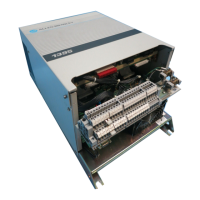2-2 Malfunctions with Indications
Soft Faults
A Soft Fault indicates a condition in which the 1395 has detected a
malfunction that could cause damage to the drive control, power
components, or the motor. It may also indicate that undesirable operating
conditions exist external to the drive. This type of fault is used to protect the
drive system components from damage due to both internal and external
malfunctions. It differs from the Hard Fault in that the 1395 can, in most
cases, maintain proper control during the fault.
A Soft Fault is a second priority fault. When it occurs the response of the
drive is to initiate a coast stop or controlled motor stop. Fault recovery is
accomplished by a Clear Fault command, a system RESET command, or by
cycling AC line power.
Examples of Soft Faults are:
Velocity Feedback Loss - Fault detected when the selected feedback device
malfunctions. The drive will respond with a coast stop.
SCR Overtemperature Trip - detected when the thermal switch opens on the
power structure heat sink. The drive will respond by initiating a controlled
motor stop.
Warning Faults
A Warning Fault is the lowest priority fault which indicates a condition that
if left uncorrected, could result in a Soft Fault. This type of fault is designed
to annunciate a condition present in the system. When a Warning Fault
occurs, the appropriate Fault Code is entered into the Fault Queue and the
Fault Status parameters reflect the condition present. The drive will not
command a stop, and operation will continue unaffected. Fault Recovery is
accomplished by initiating a Clear Fault command, but is not necessary for
continued operation. Examples of Warning Faults are:
Motor Overload Pending - Detected when the armature current exceeds
115% (default value of parameter 720) of the motor armature current rating.
The drive will respond by indicating a Warning Fault and entering a
message into the Fault Queue, if parameter 632, bit 0 is set to zero.
Bridge Overload Pending - Detected when the armature current exceeds
105% of the bridge rating. The drive will respond by indicating a Warning
Fault, and entering a message into the Fault Queue, if parameter 632, bit 2 is
set to zero.
Fault Response Selection
A number of fault conditions in the 1395 may be configured to respond as
either Soft or Warning type faults. This allows the user to control the
response of the drive to some fault conditions based on his unique
application requirements. Parameter 623 “Fault Select” is a bit coded word
which controls whether eight predetermined faults will cause a Soft or
Warning type response. Bit definitions for parameter 623, corresponding to
the eight faults, are given in
Table 2.A. A fault condition will cause a Soft
Fault at this time.
Aotewell Ltd industry-mall.net

